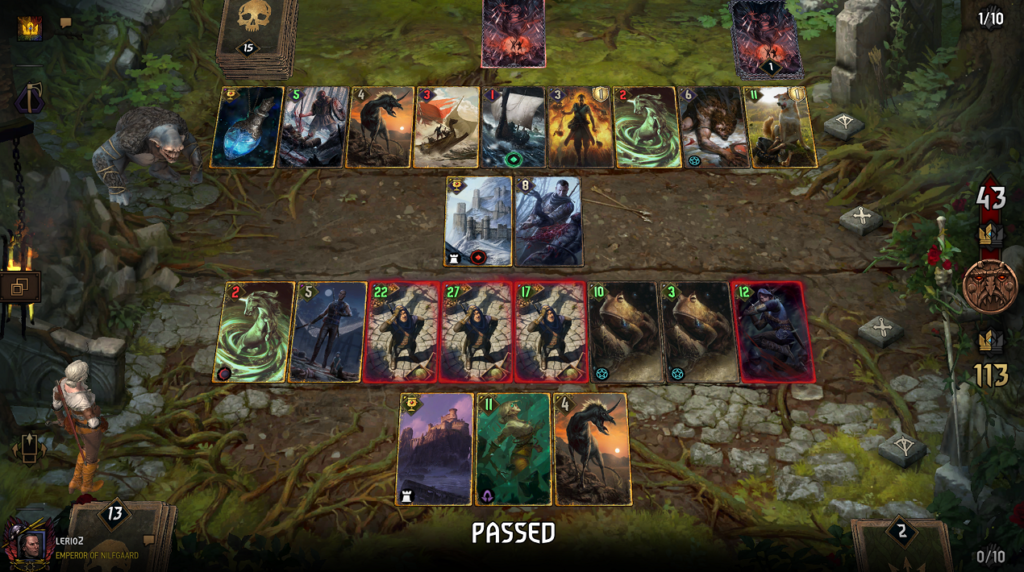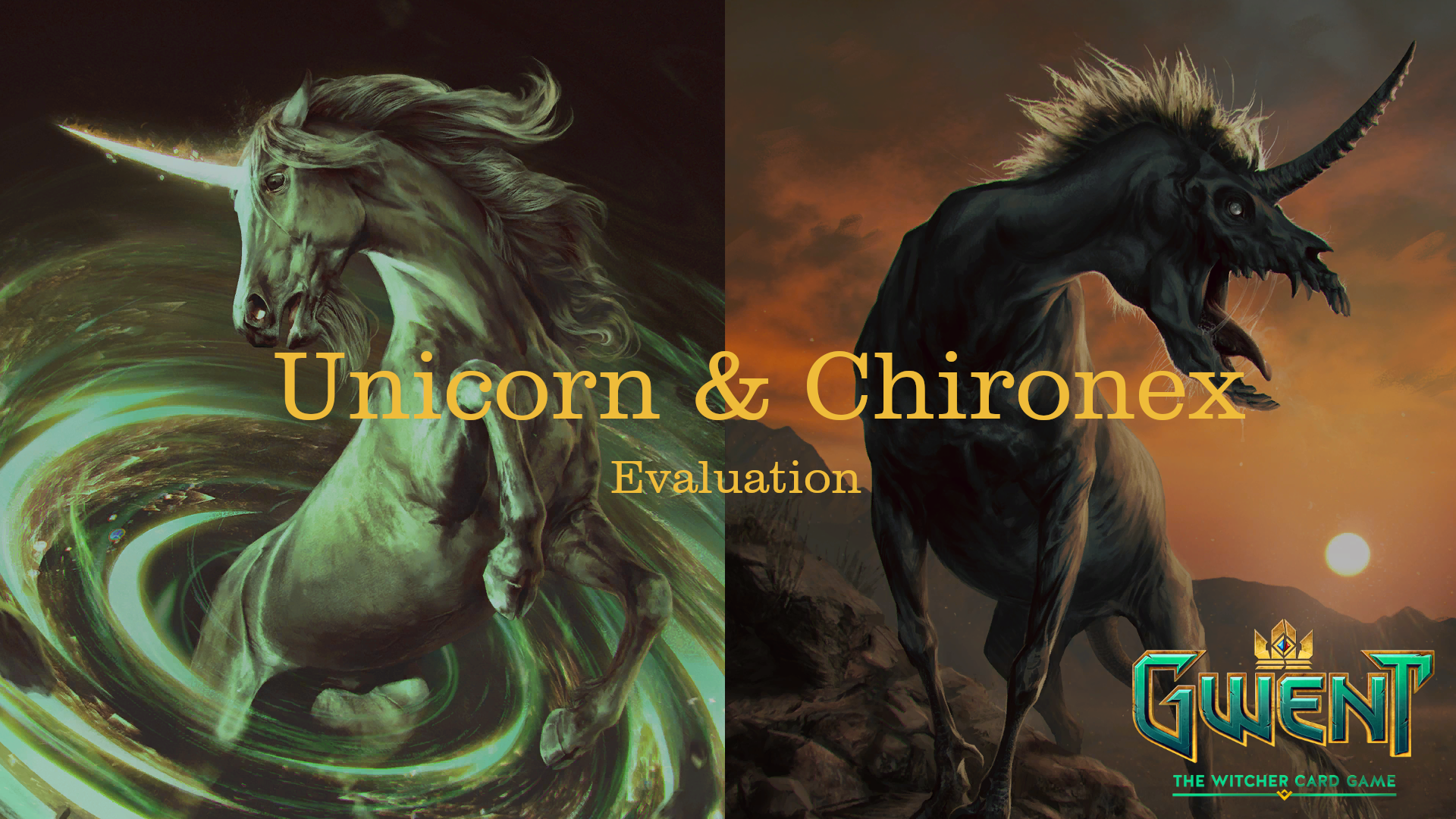A combo of cards is always prone to provision cost evaluation mistakes. A trick which simplifies life in case of any provision cost analysis is nullifying provision system.
Unicorn and Chironex each are worth 5 provision in the nullified system. Their combined excessive cost is 10, which in 4-base system used in Gwent makes 14 total provision cost.
On-board value
Neglecting card draw effect, combo plays as (4+3)+(4+6) = 17 points for 14 provision. Nothing broken by itself (compare with other 14 provision cards like Renfri or Dana; 17 points seems like a timid ceiling).
Usually Unicorn => Chironex is significantly stronger than Chironex => Unicorn. That’s because 6 points of damage could be used to remove opponent’s engine. Also +3 boost plays into tall removal less than +6.
If +1 per turn engine gets removed with U=>C, then effective value is already at ~25 points level. Control aspect in practice raises combo value by 50% or even more depending on meta.
Draw Top Card
- U+C vs UC visualization
The most troublesome part to evaluate. Let’s visualize U+C in hand and, in parallel, UC – a single card analogue of combo, with same effect, but not drawing topdeck card.
In a classical deck with weak thinning, UC would be better than U+C, thanks to control over weakest card during mulligan phase. In other words, in UC we could mulligan worst card out and guarantee it wouldn’t be played, while U+C would likely draw one of the least demanded ones, which were left in the deck.
In the context of R3 then, we have to include average topdeck quality in evaluation. Stating ’U+C = 17 for 14’ we made a hidden assumption that the topdeck power of U+C would be roughly equal to worst card kept in UC hand – probably a good bronze playing for 8 points (but it depends..).
Therefore, decks running U+C should avoid having weak residual in deck in R3; especially playing multiple tech cards is risky. Topdecking 0 point card makes U+C worth something like ’17-8 = 9 for 14’
- Controlled topdeck
On the other hand, if topdeck could be controlled, then U+C may have advantage over UC and act as a value tutor. Such setup may add a few points to ’17 for 14’ evaluation, depending on how much above the average drawn card would play. For example tutoring Albrich or Naglfar topdeck in the same round are interesting ideas.
Consistency Issue
Another weakness of U+C with respect to UC is the consistency of finding the pair itself. There is 80% chance to naturally find a single card, but only 64% to find a pair (tutoring article).
While U+C may win particular games, it is not stable enough on average to be played without tutors or hyperthinning. In (1/3) of games you would have to play discoupled U/C, probably losing game on spot. On the other hand, a single tutor makes U+C 91% consistent in R3.
The situation is even worse when the deck is supposed to play R1 (24%) or R2 (44%) actively. More often than not, a single U/C in hand would be unplayable during push
Verdict
U+C combo is too less consistent to be played in normal decks without enough thinning / tutoring. The control aspect of U+C combo (damage 6) could bring a lot of additional value and the use for massive trade up in points against engines seems reasonable. This way 20+ for 14 effective impact is possible, while otherwise combo would be no better than 17 for 14, which is rather mediocre
Practical Use
In spite of its drawbacks, Unicorn + Chironex are included in all Golden Nekker meta decks run on Pro Ladder in Gwent 11.2 (and nothing suggests it would be different in 11.3). What is the reason?
The first: GN decks have relatively high consistency. Nevertheless, each one of them runs Royal Decree, which is still necessary with U+C. Second: with 4-9 limitation, GN decks needs polarization and U+C is a cheat way to provide it thanks to cost divided on two cards. Third: those builds already have very good topdecks and barely ever play tech cards because of the risk of getting them with GN.
Check out following lists (who played, MMR):
- GN Pirates (Pajabol, 2674)
- Bounty Nekker (Pajabol, 2727)
- Hospitality Nekker (Truzky, 2640)
- Movement Nekker (lerio2, 2637)

Unicorn Hunting
Adding another pony to U+C combo elongates the chain by 1 and adds another 10 points on board. The best faction to perform such shenanigans is Nilfgaard. Running own U+C and copying at least one element from opponent it is possible to play spectacular combo chain. In such case provision considerations are less of an issue and what we want to evaluate are exact points.
Each next pony added to the pair is worth 10 + drawn card. While for the first pair we didn’t add drawn card value explicitly to point evaluation (and we still wouldn’t do it if could play triple or bigger combo explicitly in the deckbuilder), the context is different when opportunity arises during the game. In other words, the alternative is copying something else and not drawing extra card. So we simply discuss absolute points present in hand, rather than value of ponies itself.
U+C = 17 + dc
U+C+U = 27 + 2*dc (e.g. Coup no Torres)
U+C+U+C = 37 + 3*dc (e.g. single copy from Torres + Coup/Artaud)
U+C+U+C+U = 47 + 4*dc (pair from Torres + Artaud/Coup – demo)
The average power of the drawn card (dc) is very important factor here. Going from 8 to 4 points topdeck quality in the case of the last chain loses 16 points, which is more than an extra Unicorn/Chironex.
While Unicorn chain is great points, it is not always enough to win by itself, especially when facing cards like Scenarios or other powerplays.

Unicorn Hunters Enslave 6 (Mya-mon, 2680)
Closure
Thanks for reading! More write-ups on intersting subjects highlighted by the current meta to follow.



